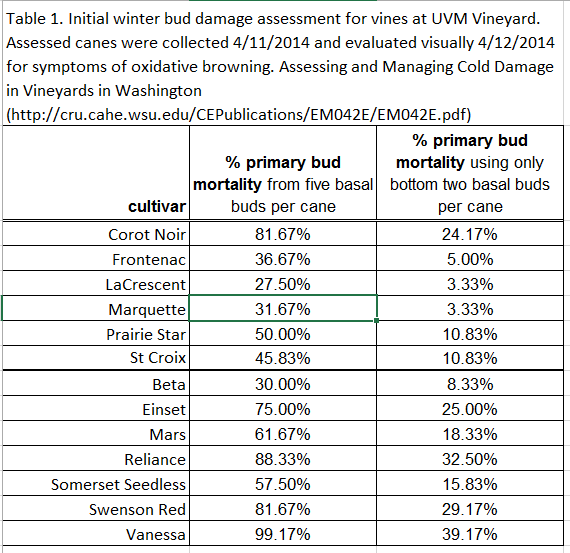April 15, 2014
Terence Bradshaw, UVM Tree Fruit and Viticulture Specialist
First, the good news- it looks like the long-range cold temperature prediction for this Thursday that I mentioned last week won’t be as bad as my weatherman thought, so feel free to prune your vines this week. The bad news- if your vineyard is anything like the UVM vineyard, you’re likely looking at significant winter bud damage out there.
We calculated our primary bud damage in two ways after last Saturday’s assessment: first using the basal five buds per cane, and again using just the bottom two. Our table grapes are looking rough, even considering just the two basal buds that would normally be retained on spurs. Winegrapes are looking a bit better, but I’m still concerned. I did not include nor yet calculate secondary bud damage, but a glance through the data shows that there are a number of buds with only tertiary or even no buds surviving. We have not yet cut into trunks or cordons, but I suspect that some vines are damaged there as well.
The take home message here for your pruning consideration, is to be cautious but thorough. Consider leaving extra retained buds on your vines this year, I would suggest more spurs rather than fewer but longer spurs. If cane pruning, consider leaving a few extra canes and be wary of bud survival as you move farther out from the basal nodes. It’s easier to thin shoots later than to add back the ones you cut off now. However, you’ll need to be thorough now and as the growing season progresses to remove ALL dead wood from the canopy, including stubs of old spurs, dead cane ends, and ends of cordons. This tissue is where disease inoculum, especially phomopsis, overwinters. Removal of that dead wood is your first line of defense against this disease that seems to be more prevalent than it used to be.
This may also be the year that you’ll need to use those replacement parts that we speak of- I mean renewing trunks and cordons. If there’s a good shoot emerging low on the trunk from last year’s retained renewal spur, keep it. You can cut it later if need be. Same for any healthy canes (i.e. those not dead after the 8-10th node) that emerge from the head renewal zone. Those may be laid down later to regrow cordons if necessary. Trunk and cordon damage may not show for some time, so don’t be too hasty to assume that everything is healthy, and that you won’t need those spare parts this year.
Please read my April 3 post which includes the latest Northern Grapes Project newsletter for more information on assessing bud injury and adjusting pruning.
Where trade names or commercial products are used for identification, no discrimination is intended and no endorsement is implied.
Always read the label before using any pesticide.
The label is the legal document for the product use.
Disregard any information in this newsletter if it is in conflict with the label.
The UVM Tree Fruit and Viticulture Program is supported by the University of Vermont Agriculture Experiment Station, a USDA NIFA E-IPM Grant, and USDA Risk Management Agency Funds.

